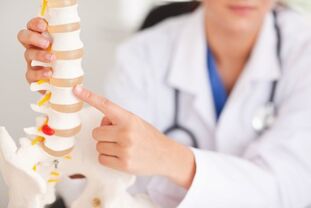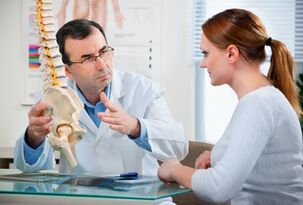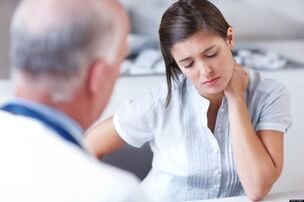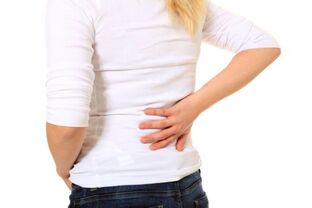
Everyone has a problem at least once in their life when their back hurts in the lumbar spine. This symptom often occurs after long periods of sitting in an uncomfortable position. The pain is harmless to health and disappears after a good break.
Treatment can only be prescribed after a complete diagnosis and determination of the cause and nature of the disease. No action can be carried out alone without a medical examination.
Various reasons
The most common causes that lead to pain syndrome: osteochondrosis, scoliosis, herniated disc. Tumors and tissue infections are much less common.
Pain manifests itself in different ways depending on the illness. If the cause of the pain is renal colic or gastric ulcer, regardless of the type of activity, the sensations are constant (a person is lying down or engaged in vigorous activity).
If there is osteochondrosis of the chest region, the pain will radiate to the heart and the patient will mistakenly think they have angina.
If the lower back hurts while lying down
When pain occurs and a person doesn't know what to do with it, they prefer to lie down and hope that the symptoms will go away. If the pain worsens when you are lying down, you most likely have a musculoskeletal disorder called ankylosing spondylitis.
The disease affects young men, changes occur in the vertebrae and they grow together, while the flexibility of the spine decreases.
Due to the fact that the spine cannot take its natural position, a person feels pain when lying down.
Ankylosing spondylitis is inherited; chronic infectious diseases stimulate its development. The pain increases when you lead a sedentary lifestyle.
The first sign is a feeling of stiffness in the spine, and when you lie down, the back pain worsens. Early diagnosis can cure the disease completely.
Primary pain syndrome

Doctors differentiate between primary and secondary pain syndromes when it comes to back pain.
The primary lower back pain syndrome involves changes in the musculoskeletal system that are of a morphofunctional nature.
These are the most common causes of pain:
- osteochondrosis (damage to bone and cartilage tissue, intervertebral disc);
- Spondyloptrosis (damage to the intervertebral joints, which affects the mobility of the spine).
Secondary pain syndrome
Secondary syndrome includes a wider variety of conditions that cause back pain in the lumbar spine:
- Scoliosis (curvature of the spine);
- reflected the pain;
- osteoporosis and osteomalacia (damage to bone tissue);
- ankylosing spondylitis (non-infectious inflammation);
- rheumatoid arthritis;
- isolated tumor or formed metastases;
- tuberculosis, epidural abscess, brucellosis (infectious diseases);
- stroke, which leads to impaired cerebrospinal blood flow;
- gastrointestinal diseases (particularly appendicitis or intestinal disease);
- diseases in the pelvic area (renal colic, sexually transmitted diseases);
- spinal fracture (the most dangerous and serious cause).
Acute pain
Lower back pain is also classified as acute and chronic. Each of them points to different reasons.
A harmless but painful manifestation of acute pain is a muscle sprain. It occurs due to the formation of cramps in the long muscles.
Athletes and professionals suffer most often. The pain is localized in the lower back, but it is clearly felt in other parts of the body as a person's mobility is restricted and the pain subsides.

Spinal injuries also lead to acute pain. The most dangerous injury is a spinal fracture.
The fracture can be caused by a fall or it can go completely unnoticed, for example if the person has Paget's disease, osteoporosis, hyperparathyroidism or a tumor.
A displacement of the intervertebral discs in the lumbar region also leads to pain. In this case, a person's mobility is severely restricted.
The pain itself is caused by compression of the nerve roots. Additional symptoms:
- violation of sensitivity;
- Decrease or complete absence of Achilles and knee reflexes;
- radicular pain.
A displacement of the vertebrae can lead to pathology of people nearby who have been healthy to the last. Diseases of the lower vertebrae lead to diseases of the bladder and intestines.
Another reason for acute pain is facet syndrome. In this case, the intervertebral disc is not affected, only compression of the root occurs, emerging from the spinal canal. The intervertebral foramen narrows due to the narrowing of the intervertebral foramen.
A serious illness like an epidural abscess can also cause pain. What should be done in this case?
The disease should not be delayed as it can have tragic consequences. It is necessary to immediately take all measures to eliminate compression of the spinal cord. Sometimes surgery is required.
In the area from the lower back to the knees, pain caused by diseases of the hip joint can occur.
Chronic pain
If the back in the lumbar region is sick and the pain is constant, hurts or pulls in nature, this indicates diseases other than acute pain.

The first reason is spondylosis deformans. The vertebrae of the lumbar spine undergo dystrophic changes, the ligaments become weaker, and bone growth begins.
As a result, bony outgrowths put pressure on the nerve roots and painful pain occurs. Numbness and weakness in the legs can be added to the symptoms.
Chronic lower back pain can be caused by cancer or metabolic disorders.
In this case, you need to conduct cancer therapy, change the daily regimen and diet to eliminate the root cause. Everything else is ineffective.
Another cause is osteomyelitis, when an infection enters the bone and causes inflammation.
Illnesses that lead to back pain
Other conditions that cause lumbar pain
- facet arthropathy;
- stenosis of the spine;
- herniated disc;
- myogenic pain;
- Fracture of the annulus fibrosus.
In women, pain can be triggered by diseases of the pelvis such as endometriosis, uterine and ovarian cancer. In men - prostatitis or prostate cancer.

Diseased kidneys, a tumor in the stomach, duodenum can also be in the lumbar region. Pain occurs with ulcerative colitis, colon tumors, and diverticulitis.
If the pain extends not only to the lumbar spine but also to the chest area, it is important to rule out the possibility of aortic dissection.
Harmless causes can be physiological changes, e. g. B. the postpartum period or a sharp increase in mass, the effect of epidural anesthesia.
The treatment of such pain is not carried out, the patient cannot do anything, the pain disappears by itself after a certain time.
Treatment of the lumbar spine
Before starting treatment, it is necessary to make a correct diagnosis. First, the doctor conducts a clinical examination of the patient and then relies on the results of ultrasound and MRI exams.
Based on the diagnosis, a treatment program is selected that combines various methods.
First of all, treatment is aimed at eliminating pain, in order to bring the patient back to a comfortable life. After all, a complete cure from the disease can take years (if possible).
If a bruise is the cause of the disease, a traumatologist will perform treatment. Depending on the cause of the pain, which the therapist / family doctor should identify, an orthopedist, nephrologist, urologist, proctologist, gynecologist, cardiologist, gastroenterologist, pulmonologist and specialist in infectious diseases can keep another medical history.
So far, back pain has only been treated with antibiotics. Now there are so many treatments available that only a skilled doctor can help you choose the right one.
In order to alleviate the patient's condition, it is recommended to replace the mattress with an orthopedic one. The pain is eliminated by using anesthetic warming ointments and gels, which additionally contain anti-inflammatory components.
The use of nonsteroidal anti-inflammatory drugs is also advisable. Muscle spasms relieve muscle relaxants, edema of the nerve root eliminate diuretics and vascular drugs.
When the patient can return to normal life, treatment continues with physical therapy, massage and therapeutic exercises.
Treatment is carried out using the following non-drug methods:
- vacuum therapy;
- acupuncture;
- laser therapy;
- manual therapy;
- dry traction;
- pharmacopuncture;
- electrical stimulation;
- Magnetopuncture.
This treatment provides rapid pain relief and also eliminates the cause itself, ensuring long-term results.






























